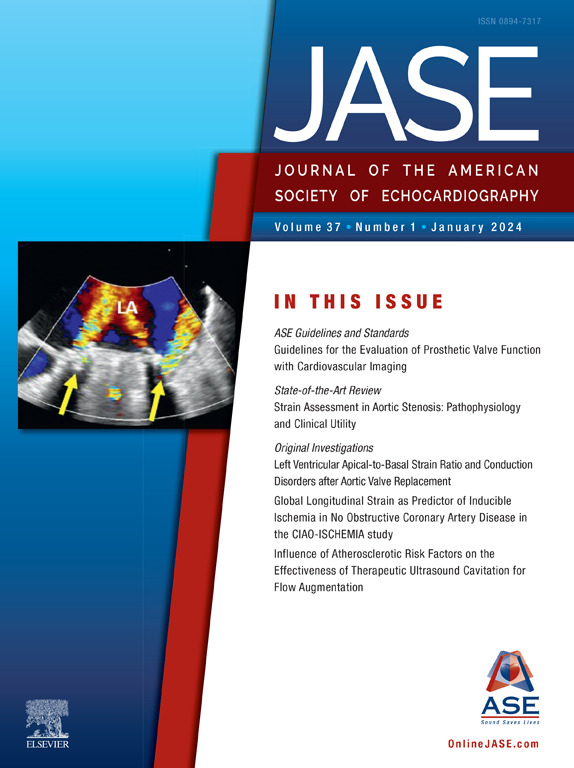Atrial Right-to-Left Shunting After Tetralogy of Fallot Repair Is Associated With Improved Atrial Function and Shorter Hospital Length of Stay: An Echocardiographic Cohort Study
IF 6
2区 医学
Q1 CARDIAC & CARDIOVASCULAR SYSTEMS
Journal of the American Society of Echocardiography
Pub Date : 2025-08-01
DOI:10.1016/j.echo.2025.04.020
引用次数: 0
Abstract
Background
Atrial right-to-left (aRL) shunting is often identified on echocardiography in the early postoperative period following repair of tetralogy of Fallot (TOF) and is thought to reflect poor right ventricular (RV) compliance but to be possibly beneficial in serving as a “pop-off” for the right ventricle. The aim of this study was to investigate the relationship between aRL shunting and echocardiographic diastolic function and early postoperative outcomes, hypothesizing that aRL shunting would be associated with worse diastolic function and with postoperative length of stay (LOS).
Methods
A single-center cohort study was conducted among patients who underwent repair of TOF. Echocardiograms were obtained 2 to 5 days after repair. Patients were grouped as “elective” if repaired after 30 days of age without prior palliation, “staged” if they underwent neonatal palliation before repair, or “neonatal” if repaired at <30 days age. aRL shunting was compared with all others: bidirectional, left-to-right shunt, and no atrial shunt detected. Linear regression tested the relationship of aRL shunting with right atrial volumes and right atrial emptying fraction (RAEF), RV inflow and tissue Doppler velocities, and RA peak longitudinal strain and early strain rate. Multivariable negative binomial regression was conducted to test the association between aRL shunting and LOS, stratified by repair group.
Results
There were 197 patients with TOF (60% male, 74% white): (127 [64%]) underwent elective repair, 41 (21%) staged repair, and 29 (15%) neonatal repair. aRL shunting was present in 68 patients (35%). In the overall cohort, aRL shunting was associated with lower right atrial end-diastolic volume, higher RAEF, higher A-wave peak velocity, and higher right atrial peak longitudinal strain. In the subgroup analysis, aRL shunting was associated with higher RAEF and peak longitudinal strain in the elective repair group only, in which aRL shunting was also associated with shorter LOS.
Conclusions
aRL shunting after TOF repair is associated with better atrial function and possibly with a combination of robust atrial function in the presence of RV noncompliance and shorter LOS in patients undergoing elective TOF repair, but not in those undergoing neonatal intervention.
法洛四联修复后心房右向左分流与改善心房功能和缩短住院时间有关——一项超声心动图队列研究
背景:在法洛四联症(TOF)修复术后早期超声心动图上经常发现心房右至左(aRL)分流,并被认为是右心室(RV)顺应性差的反映,但可能有利于右心室(RV)的“弹出”。我们的目的是研究aRL分流与超声心动图舒张功能和术后早期预后之间的关系,假设aRL与舒张功能恶化和术后住院时间(LOS)有关。方法:对接受TOF修复术的患者进行单中心队列研究。修复后2-5天超声心动图。如果患者在30天后没有事先缓解,则分为“选择性”修复,如果他们在修复前有新生儿缓解,则分为“分期”修复,如果修复,则分为“新生儿”修复。结果:197例TOF患者(60%男性,74%白人),大多数(127.64%)为选择性修复,41例(21%)为分期修复,29例(15%)为新生儿修复。68例(35%)患者出现aRL。在整个队列中,aRL分流与RA舒张末期容积较低、RAEF较高、A波峰速度较高和RA峰纵向应变较高相关。在亚组分析中,仅在选择性修复组中,aRL与较高的RAEF和峰值纵向应变相关,其中aRL也与较短的LOS相关。结论:TOF修复后的aRL与更好的心房功能相关,并且可能与选择性rTOF患者在RV不符合情况下强健的心房功能和更短的LOS相关,但与接受新生儿干预的患者无关。
本文章由计算机程序翻译,如有差异,请以英文原文为准。
求助全文
约1分钟内获得全文
求助全文
来源期刊
CiteScore
9.50
自引率
12.30%
发文量
257
审稿时长
66 days
期刊介绍:
The Journal of the American Society of Echocardiography(JASE) brings physicians and sonographers peer-reviewed original investigations and state-of-the-art review articles that cover conventional clinical applications of cardiovascular ultrasound, as well as newer techniques with emerging clinical applications. These include three-dimensional echocardiography, strain and strain rate methods for evaluating cardiac mechanics and interventional applications.

 求助内容:
求助内容: 应助结果提醒方式:
应助结果提醒方式:


